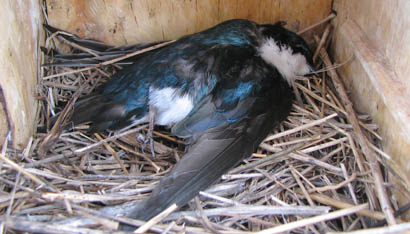
At Your Boxes:
In spite of the thought, planning and care you put into your project sooner or later there’s bound to be some mortality, due to things beyond your control. Some eggs didn’t hatch due to embryo death or infertility, and you may have discovered dead young or adults. Since death is a constant possibility for songbirds, let’s review some common causes of Tree Swallow mortality.
Concepts:
Death comes in many ways for songbirds. Life for most is short. Tree Swallow average lifespan has been calculated to be less than three years, similar to the expectancy for many other familiar songbirds. Most live through only a couple of breeding seasons, if that. Many die without leaving descendants.
Dangers to adults and young birds vary with species, season, life style and location. The following factors are all possible causes of Tree Swallow mortality during the nesting season.
Starvation and Hypothermia (exposure) of adults:
- Prolonged periods of cold, wet, windy weather, especially early in the nesting season, that ground flying insects or make foraging difficult, can starve birds that depend on them for food.
- Adult Tree Swallows are potentially susceptible to cold, rainy or snowy spells because they migrate north so early.
- In bad weather many adults may crowd into one box to keep warm. But some swallows in these “communal roosts” may die, as the seven emaciated, feces-smeared, barely recognizable swallows below did. You may also find birds dead or dying on the ground below boxes.
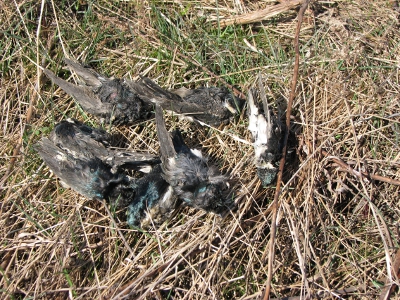
- The swallow below was caught by cold spring weather and, unable to find food, burned its own tissues to keep alive.
- Notice how the flight muscles that attached to its breastbone shrank to the point where flight was impossible. Once its last resources were gone it died of starvation and hypothermia.
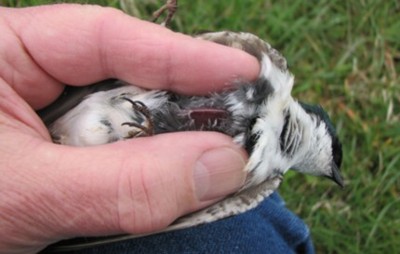
Chilling/Hypothermia and starvation of nestlings:
- Nestling swallows are utterly dependent on their parents for food. They face disaster when most insects stop flying during cold, wet, windy weather.
- Prolonged cold temperatures are most apt to kill because the young must go without energy from food just when they need it most to keep warm.
- Chilled young need extra brooding by their mother, but this reduces her foraging time under conditions when adults already have difficulty finding food.
- Research has shown nestlings 6-9 days old are most vulnerable, because they aren’t fully able to generate enough of their own body heat and their feathers aren’t developed enough to provide sufficient protection from heat loss.
- Starvation and chilling take the smallest and weakest first (see below: 3 dead at left, 2 survivors at right), but all may die if food intake is cut dramatically by prolonged bad weather.
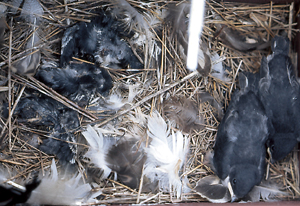
Overheating/Hyperthermia of nestlings:
- Tree Swallow nestlings can also die from too much heat (hyperthermia), especially if temperatures inside a box exceed 35 degrees C (95 degrees F).
- Adding ventilation holes to boxes in hot locations can reduce the chance of overheating. Vents that can be plugged during cold snaps are best.
- Boxes with interiors at least 5″ x 5″, which allow young in a brood to spread out and cool off, also help prevent hyperthermia. Please don’t use small boxes.
- See the bluebird web site Sialis’ excellent page for more information on heat protection in bird nest boxes.
Loss of a parent:
- It usually takes two adults working hard to feed both their nestlings and themselves. Loss of one parent may doom some of the nestlings, unless the remaining parent has an exceptionally good food supply.
- Females appear to be much better able than males to raise young on their own.
- If you are certain, absolutely certain, that the female or both parents of a Tree Swallow brood have died or deserted, consider contacting a rehabilitator with experience raising and releasing insectivorous nestlings.
- To find wildlife rehabilitators near you use this link: https://wildliferehabber.org/.
- You can also do an online search for rehabbers in your area with experience raising nestling songbirds. Your conservation department or local veterinarians might be able to help.
Nest site competition from other species (Interspecific Competition):
- Other cavity nesting species may take a swallow’s nest site, killing adult swallows, eggs, or nestlings in the process.
- House Wrens are major competitors for cavities in or near trees and shrubs. Missing eggs, eggs with double holes, and broken eggs beneath boxes are typical wren damage. The swallow nest box below facing front is in danger from the lurking wren.
- For more on House Wren competition check this page: Reducing House Wren Damage to Tree Swallow Nestings.
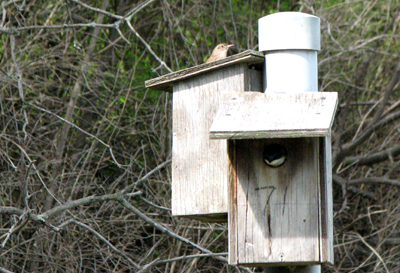
- House (English) Sparrows (below left) are also major competitors for cavities and causes of mortality of Tree Swallows. They will kill adult Tree Swallows they trap in a box. Sadly, it’s common to find dead swallows and bluebirds buried under House Sparrow nests.
- In the picture below right by Dick Stauffer, House Sparrows killed and covered several adult Tree Swallows. (We hope you’ve located your boxes as far as possible from houses and other buildings where House Sparrows congregate).

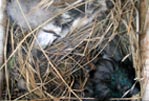
- Please note: House Sparrows are not native, and not protected by law. If you find House Sparrows using one of your boxes remove their nest and relocate the box and other nearby boxes to safer places. If the problem persists you may need to relocate your entire project.
- You don’t want to find dead Tree Swallows in your boxes, like the one below killed by a House Sparrow. Photo from Bill Zagar.
- To learn more about House Sparrow competition check: House Sparrow Damage to Tree Swallow Nestings.
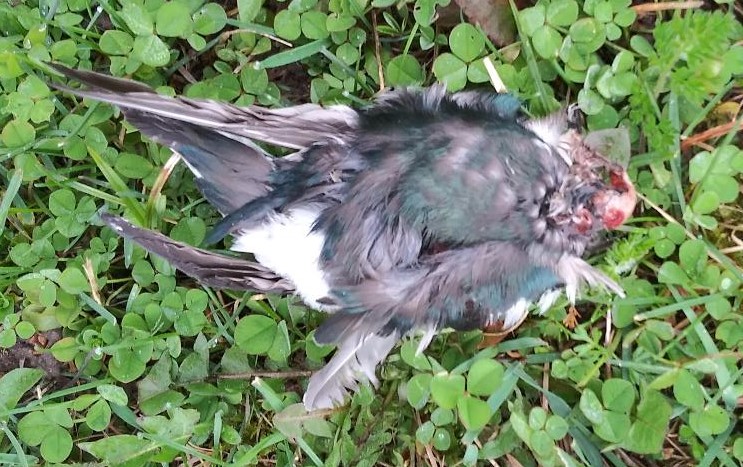
- Bluebirds outweigh Tree Swallows (30 gm to 20 gm). Determined bluebirds can oust swallows and destroy nest contents. Luckily, there are ways to minimize bluebird-swallow competition by using proper box spacing and pairing boxes. Check this page: Reducing Competition between Bluebirds and Tree Swallows.
- Small entrances and field location discourage competition from large birds like Starlings, American Kestrels, Screech Owls, Flickers, and Grackles. However, Tree Swallows nesting in natural cavities may be vulnerable to all these species, and more.
Nest site competition from other Tree Swallows (Intraspecific Competition):
- You’ve seen that Tree Swallows, both females and males, compete fiercely for limited nest sites. Fight losers can die if trapped, pinned down, and struck repeatedly on the head by the victor’s bill.
- Examine dead adults for head wounds. They may be barely noticeable, like the puncture wounds behind the eye of the bird on the left, or obvious like those on the bird to the right. Photo at right by Dick Stauffer. (Note: House Sparrows also kill by this method and leave similar marks).
- For more on Tree Swallow versus Tree Swallow strife see Nest Site Competition and Box Claiming.


Infanticide:
- Infanticide is a special type of intraspecific competition.
- Nestlings are sometimes killed by floating adult Tree Swallows attempting to take over a nest site. This demonstrates again how intensely these birds compete for a chance to reproduce.
- A male trying a takeover may throw out the resident male’s young if they are small enough to carry, or may peck older young to death. This infanticide may induce the resident female to re-mate with the new male and produce a new set of young that are his own descendants.
- Floater females may kill small young to force resident females to yield their nest sites.
- Be aware of the role infanticide may take in takeover attempts. Discovering small young with wounds like the bloody gash on the head of the nestling below, or that small nestlings are disappearing from a box, may signal that a takeover attempt is in progress. But keep in mind resident adults may remove their own small nestlings that die of other causes.
- If you find nestlings with wounds such as that below, daily application of an anti-bacterial ointment may aid healing. This nestling survived.
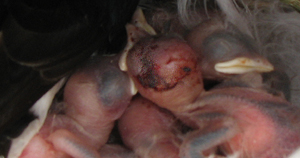
Predators:
- Many animals search for bird nests and eat any eggs, nestlings and adults they find.
- Mammals that are causes of Tree Swallow mortality at nests include raccoons, cats, weasels, squirrels, chipmunks and possums.
- Signs that mammalian predators were present include torn up nests, nest material pulled out entrances, and uneaten wings and feet on the ground below boxes.
- Nests where all nestlings disappear at once but the nest is undisturbed may have been predated by a constricting snake able to climb to the cavity, or by small mammals such as chipmunks or weasels.
- You’ve heard Tree Swallows give “Alarm Calls,” and you’ve probably been “mobbed” and dived on. These behaviors are meant to distract or scare predators. However, in reality there isn’t much Tree Swallows can do to stop determined predators from reaching their nests.
- Some large birds, including Crows, Jays and Grackles, raid nests of other birds. Tree Swallows use calls, dive-bombing, mobbing and even physical attacks to drive avian predators away, and sometimes they succeed. The swallow in the photo below from Kay and Bert Grant has actually grabbed the back of a nest-raiding Magpie with its feet and is pecking its head.
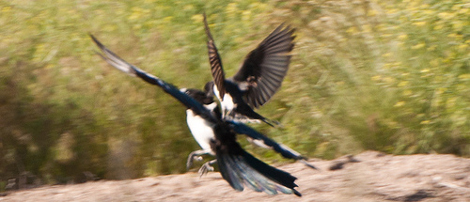
- You’ve done your best to prevent nest predation by locating boxes away from predator lanes, and by using pole guards and grease bands.
- Grease bands also deter ants, which can infest nests, and torment or kill nestlings.
- Even such superb fliers as Tree Swallows can be caught by raptors like Sharp-shinned Hawks, Cooper’s Hawks, Merlins, and Kestrels.
- Look carefully and you’ll see the Merlin in the photo below from Tony Leukering 2011 is carrying a Tree Swallow. Inexperienced, slower-flying juvenile swallows are most vulnerable to raptor attack.
- Placing boxes well out in open fields allows your swallows to spot incoming raptors at a distance.
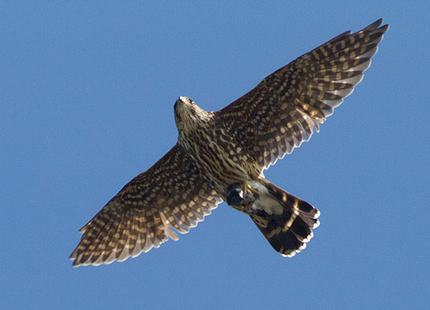
Disease:
- Like all birds, Tree Swallow adults and nestlings are susceptible to disease.
- Viral, bacterial, fungal and protozoan diseases are all causes of Tree Swallow mortality.
- The growth distorting the bird’s bill bird below is suggestive of Avian Pox, a viral disease. Photo by Dick Stauffer.
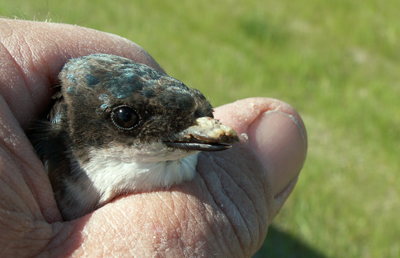
- Note the eye of the dead adult below. It may have died from complications of Avian Pox or perhaps from Avian Conjunctivitis, a bacterial disease.
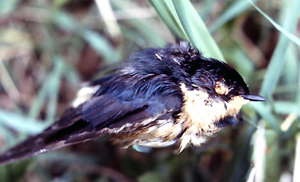
- Diseases tend to hit individuals with stressed immune systems hardest, like those already weakened by starvation, cold, injuries, or parasites.
Ectoparasites:
- Tree Swallows and their nests often harbor ectoparasites, such as blowfly larvae, fleas, and mites, that suck body fluids of nestlings and adults. Do you see the little dots on the mud rim of the Barn Swallow nest below? Those are mites.
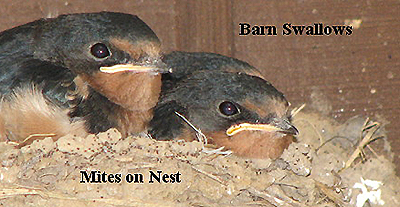
- Very few ectoparasites kill swallow nestlings directly.
- However, ectoparasites can stunt nestling growth, weaken them, and make them disease prone and less apt to survive after fledging.
- Mites can be a serious indirect cause of Tree Swallow nestling mortality because parent swallows may refuse to enter boxes having heavy infestations of mites, abandoning their nestlings to starve.
- Click here for control of nest mites.
- Songbirds like swallows also host a variety of internal, or endoparasites.
- Click here to view the Purple Martin Conservation Association’s outstanding page on ectoparasites and their effects. Purple Martins are large swallows that host many of the same type of parasites as Tree Swallows.
- Also see our page Ectoparasites of Tree Swallow.
Developmental Abnormalities:
- Some Tree Swallow embryos fail to develop normally for a variety of causes.
- Abnormalities may be lethal to embryos in eggs or later to young swallows during nestling stages or even after fledging.
- As long as parents cared for the nestling below it survived. However, its abnormal foot will jeopardize its chances as an independent bird. Photo by Dick Stauffer.
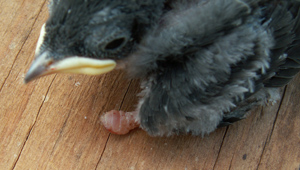
Human activity:
- Unfortunately, vandalism and disturbance by curious people are causes of Tree Swallow mortality. Adult Tree Swallows may desert eggs and nestlings when disturbed too much.
- Contamination of local environments and food supplies by toxic pesticides, herbicides, and industrial pollutants may also threaten swallow survival through disruption of their bodies’ internal metabolic processes.
- Collision with vehicles can take a toll when nest sites are located near roads and after nesting when swallows sun themselves on road surfaces. Photo below of a road-killed juvenile Tree Swallow by Laura Erickson.
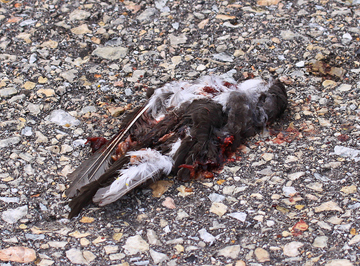
- Check an additional discussion of Tree Swallow mortality at the bluebird hobbyist website Sialis’ entry regarding dead Tree Swallows in nest boxes.
Questions for the next Topic: Older Tree Swallow Nestling Development
- Why must box checks stop after nestling day 12?
- What behaviors indicate nestlings will soon be leaving their nests?
—————————————————————————————
Home: Tree Swallow Nest Box Projects
Creating Tree Swallow Nest Box Projects
Spring Return
Nesting Season Behavior
Song and Calls
Nest Site Claiming
Pair Formation
Nest Building
Bird Flight
Mating and Paternity
Diary of One Season at Salmon Creek
Monitoring Nest Boxes and Keeping Records
Making Box Checks Keeping Box Records Control Sheets Season Summaries Print Sheets
Banding Your Tree Swallows Banding Adults Banding Nestlings
Tree Swallows in Research Research Bibliography Glossary of Terms